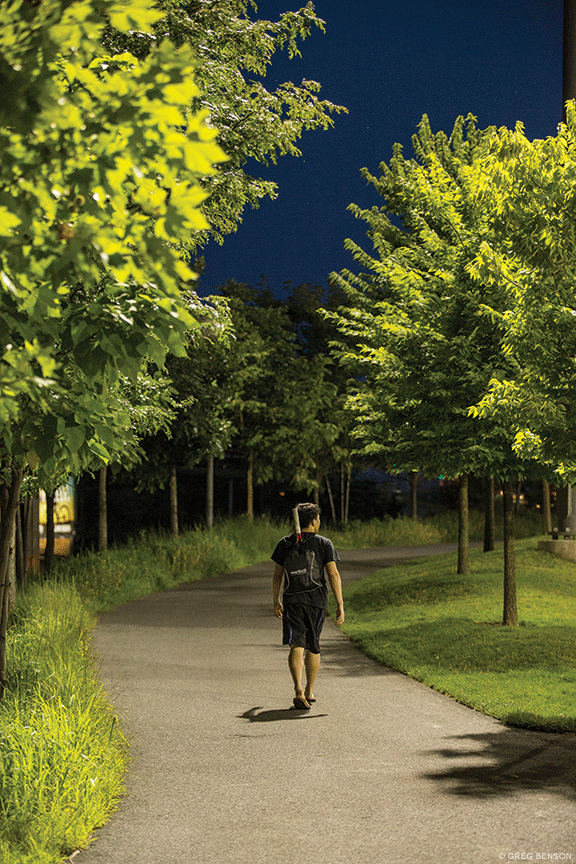
As longtime Athletic Director Steve Bilsky W’71 departs Weightman Hall, how will his 20-year tenure be remembered? And where will his successor, M. Grace Calhoun, take Penn athletics?
BY DAVE ZEITLIN | Photography by Greg Benson
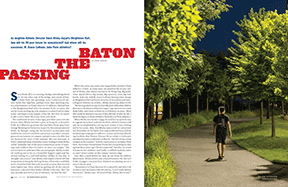
Steve Bilsky W’71 is crossing a bridge and talking about U2. On the other side of the bridge, just ahead of him, is Penn Park, the sprawling 14-acre collection of athletic fields that signifies, perhaps more than anything else, his achievements as Penn’s director of athletics. Behind him is the Weightman Hall office he worked in for 20 years, the one he’s now packing up as he prepares to retire from his alma mater and begin a new chapter of his life. But first, he wants to tell a story about the iconic Irish rock band.
The condensed version: It was 1997, just three years into his tenure, when Bilsky hatched a plan to bring U2 to Franklin Field. As a Wharton graduate who had been hired away from George Washington University in part for his entrepreneurial skills, he thought using the University’s 50,000-plus-seat stadium for concerts would be a great way to produce revenue, generate excitement on campus, and put to use a facility that lay dormant for most of the summer. But not everyone in Penn’s administration shared his vision, leading to what Bilsky called “probably one of the most contentious series of meetings and conflicts that I’ve had in 20 years on campus.” The concert went on, with more than 50,000 people—Bilsky included—rocking out to U2 on a beautiful August night and the school reeling in a cool half-million dollars in one day. “I thought I was a hero,” says Bilsky, who hoped to build off that momentum to bring the Rolling Stones, Elton John, and Billy Joel to Franklin Field. But with security an issue that worried some higher-ups, Penn ended up getting out of the concert business—a decision that bothers Bilsky to this day. “But,” he says proudly and with a hint of defiance, “we had the one.”
While this story may seem only tangentially related to Penn athletics, it does, in many ways, encapsulate the 20-year tenure of Bilsky, who always wanted to do things big. Big ambitions. Big facilities. Big money. Big opinions. Even big rock bands. And now, with M. Grace Calhoun having taken charge in Weightman Hall as Penn’s director of recreation and intercollegiate athletics as of July 1, Bilsky leaves big shoes to fill.
“He has to go down as one of, if not the, most influential athletic directors in the history of the Ivy League,” says men’s soccer coach Rudy Fuller, who’s been at Penn for 17 of Bilsky’s 20 years. “Most ADs would be deemed a success if they did half of what he did. I think his legacy is firmly etched in the history of Penn athletics.”
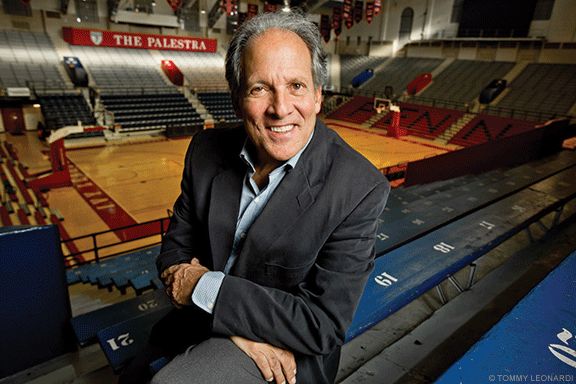
When Bilsky was hired in 1994, he said his top priority was to upgrade the school’s athletic facilities, which he knew could only be accomplished by raising more money. It was a fitting end to his career, then, that Bilsky announced his retirement last November on the heels of an unprecedented $125 million fundraising campaign for athletics, money used toward building facilities that Provost Vincent Price called, in Calhoun’s introductory press conference in March, “the best of any urban campus in the country.” And the centerpiece is certainly Penn Park, the former United States Postal Service parking lot that opened three years ago [“Penn Connected,” Nov|Dec 2011] and is home to two synthetic-turf fields, a softball stadium, and a 12-court tennis center on the campus’ eastern edge.
Less than a week before his June 30 exit from the athletic department, Bilsky settles into a bench between the two turf fields. A jogger runs past him. Children are playing soccer a stone’s throw away.
“Sometimes I sit here because it’s so peaceful and take it all in and scratch my head a little bit and say, ‘I can’t really believe this exists,’” Bilsky says. “It’s kind of like, ‘Whoa, this is real.’”
Bilsky had plenty of time to reflect on his accomplishments between the surprising announcement that he would retire and his last day on the job—a seven-month transition period that helped acclimate Calhoun, a long-time athletic administrator who was hired on March 24 after an extensive search by a 14-member advisory committee (chaired by Price and Executive Vice President Craig Carnaroli W’85). But in his final days, weeks, and months on the job, Bilsky did more than ponder what he did right—a laundry list of achievements that ranged from heading a broad-based athletic program in which 21 different teams won a total of 75 Ivy League championships to spearheading the formation of the Ivy League Digital Network, the subscription-based streaming service that brings conference games to anyone with Internet access.
He’s also expressed concern over the future of Penn sports. He isn’t worried because of Calhoun (who he believes will chart a positive path for the department) or the University’s administration (with whom, aside from the tiff over U2, he always had a good working relationship). His concerns revolve around events mostly out of Penn’s control (like the Ivy League’s place in a changing National Collegiate Athletic Association landscape) and trends he believes are caused by shifting demographics at colleges around the country (like sagging attendance at basketball and football games).
There are those who will point the finger of blame at Bilsky for the decline in attendance for men’s basketball games at the Palestra. It was under his watch, after all, that the Quakers took a hard tumble from their perch atop the league. But Bilsky insists that the team—for which he starred from 1968-71, when the Quakers were a national powerhouse—will soon make a comeback. What worries him more is the possibility that the changing NCAA landscape—in which the country’s biggest athletic programs are forming huge super-conferences that revolve around TV contracts and major football dollars—may eventually cause the Ivy League to slip from the most-competitive Division I model to Division III, in which sports are deemphasized. And that, in turn, will cause Penn basketball to lose its luster as a program that’s always had big aspirations, even in down years.
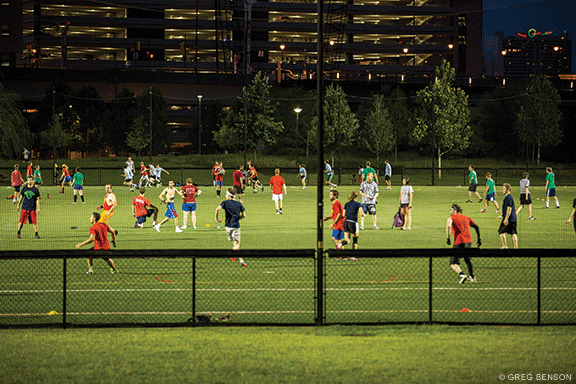
As he crosses back over the Penn Park bridge to return to an office cluttered with boxes, the historic Palestra to his right and Franklin Field to his left, Bilsky closes with a gloomy thought—one mixed with nostalgia and dread.
“You know why it’s really, really important to persevere and sustain the importance of athletics? Because your first story about your child could very well be the time you took him to the Palestra when he was three months old,” he says. “Wouldn’t it be terrible if down the road you don’t have a Palestra story? To me, it would be a real sin.”
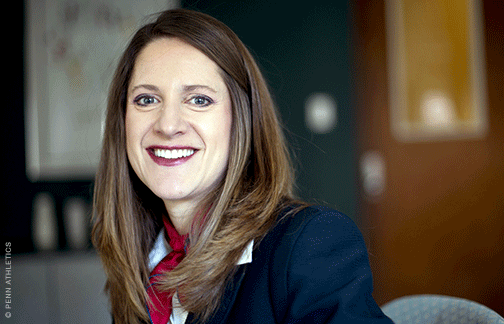
M. Grace Calhoun doesn’t need to be convinced of the importance of athletics. She grew up a competitive gymnast, ran track in the Ivy League at Brown, got her start in athletic administration while at grad school at the University of Florida, and honed her skills at another big-time athletic program—Indiana University.
Now, after other stops at Dartmouth, Saint Francis (Pennsylvania), the Patriot League, and, most recently, Loyola University Chicago, she’s sitting at a circular table in front of a single notepad inside Weightman Hall. It’s her first week on the job at Penn and Bilsky’s old office is currently being painted, leaving her to work in an empty room on the other side of the building. That suits her just fine; the window in her temporary office overlooks Franklin Field, the country’s oldest two-tiered football stadium.
“The history and the tradition comes through much more loud and clear here than really any place I’ve been,” she says. “I would say probably the closest was Indiana with the basketball program. You walk around Penn’s facilities and—it hasn’t gotten old yet—I continue to get those goosebumps and say, ‘Wow, this is Franklin Field.’”
With Penn’s athletic department on very solid footing, Calhoun has the luxury of taking some time early in her tenure to be in awe. Ever since landing the job, she’s made sure to express appreciation, especially about being the first female athletic director in the Big 5, the collection of long-standing Division I Philadelphia basketball rivals—Penn, Temple, Villanova, Saint Joseph’s, and La Salle. (Upon leaving Penn, Bilsky was named executive director of the group.)
At her introductory press conference, Calhoun said: “I need to ensure that I do a fantastic job because I know if I do so I’m helping open doors for other women.” But she’s been predictably—and perhaps unavoidably—vague on the specifics, focusing on meeting with coaches and getting acclimated to the University before revealing a checklist of things to accomplish.
“You have to fight the temptation that, now it’s July 1 and everyone is, like, ‘Where’s my project?’ and ‘What are we doing on this?’” she says. “You’re realizing it’s going to be a process … Things, by and large, are really going well—and we just have to figure out how to make it even better.”
Not having “any gaping holes to fix,” as she puts it, certainly alleviates some immediate responsibility, but it also, in some ways, adds to the pressure on Calhoun. Following in Bilsky’s footsteps, after all, is no easy task. On top of Penn Park, the list of facilities built or upgraded in the last few years alone is remarkable and includes Weiss Pavilion, a weight-training room on the northern end of Franklin Field that Soccer Coach Fuller would “put up against any weight room in the country;” the Tse Ping & Cheng Cheung Ling Sports Center, which transformed creaky Hutchinson Gymnasium into a spanking new sports haven that features a basketball practice court and offices for the coaches, as well as new centers for fencing, gymnastics, rowing, golf, and wrestling; and Ellen Vagelos C’90 Field, the school’s first-ever AstroTurf field-hockey venue, which opened last year.
During Bilsky’s watch, Penn also built Meiklejohn Stadium, a beautiful ballpark for the baseball team in the shadow of the Schuylkill Expressway, and the David Pottruck Health and Fitness Center on Walnut Street, while upgrading and maintaining two of the most iconic buildings in Philadelphia (and college sports): the Palestra and Franklin Field.
The physical improvements have translated into programmatic success, with the softball team capturing its first Ivy League title since 1981 a year after its Penn Park field opened, the field hockey team finishing one win shy of the program record for victories in its first season playing in its new stadium, and the men’s and women’s soccer teams emerging as perennial league powerhouses thanks in large part to the renovations made to Rhodes Field, which men’s coach Fuller says used to be “on par with a high-school facility” and is now “one of the best facilities in the region.”
“Steve’s legacy is going to be that he’s transformed the athletic facilities to a point that they are unparalleled within our league and arguably among the nation’s best,” says Al Bagnoli, the George A. Munger Head Coach of Football, who’s won nine Ivy League championships and will retire at the end of the 2014 season [“Gazetteer,” July|Aug]. “His legacy is always going to be that he had the vision—and the brashness. We had to raise a lot of money. Some people would be deterred by that amount, but I think one of Steve’s great strengths is that he’s a big thinker. He’s a bold thinker. He’s not intimidated by the magnitude of the projects.”
While athletics’ $125 million fundraising project, part of the University’s broader Making History campaign [“Big Finish, Fresh Start,” Mar|Apr 2013], was a landmark achievement, Bilsky has been successfully raising money throughout his tenure. Calling himself the “CEO of a big enterprise,” Bilsky has worked closely with the development office to ensure that the department covers all of its athletic costs—which, per the Equity in Athletics Disclosure Act (EADA), was $39,045,564 for the 2013 fiscal year that concluded on June 30, 2013, the highest of any Ivy League university. Bilsky estimates that about half of that $39 million budget (which covers operating expenses for the 31 varsity teams, coaches’ salaries, recruiting travel costs, and more) comes from “sources within the University, whether that’s tuition dollars that come to us” or recreation fees that students must pay in exchange for access to Pottruck. Additional money comes from corporate sponsorships, ticketing, and the Penn Relays—the annual track meet held at Franklin Field that Bilsky calls a “multi-million-dollar endeavor.”
But like most athletic departments, Penn’s is not profitable. To stay above water, it must consistently reach out to potential donors—many of whom are former players—and convince them to help support the next generation of student-athletes.
“Every year I’ve been here, we balanced the budget,” Bilsky says proudly. “Every team’s budget is a combination of money they get from the University and money we have to raise, through gifts and endowments. We have a development office I spend a lot of time with, and we raise money. People believe in this model. I’m not saying raising money is easy. But we’ve been so successful raising money we must be making a good argument, and we must be doing it well because we’ve never not met our goal.”
Calhoun knows what needs to be done to continue along that path. In her first press conference with reporters in March, she said she loves the fundraising part of the job, adding: “From today, I plan to ask for a list of phone numbers to start making those connections.” Now, she’s ready to back it up and make sure that Penn “doesn’t just rest on our laurels.”
“So many institutions have had a natural lull or downturn after a big campaign,” she says. “So obviously the focus will be to make sure we do nothing but move forward.”

For a certain subset of alumni fans, the glories of Penn Park, etc. fade next to the precipitous decline of men’s basketball in recent years.
Jonathan Bart C’78 called basketball games on WXPN when he was a student, has been a season-ticket holder at the Palestra for more than 20 years, and is an active poster on the Ivy League basketball message boards—all of which is to say there are few bigger Penn hoops fans than him. But after decades of rabid devotion to the Quakers, Bart did something last season he had never done before: he left a game at halftime. It had simply gotten too hard to watch the continued freefall of the once-mighty program from his second-row seat at midcourt. “Last year,” Bart says bluntly, “was frankly an embarrassment.”
This, of course, is the opinion of just one alumnus. But judging by attendance figures, you could certainly make the case that he’s not alone in that sentiment—and that the University’s most popular team is steadily becoming less popular. After easily surpassing 5,000 fans per game, on average, for all but one season from 1998-99 to 2006-07 (a remarkable nine-year stretch that included seven Ivy League championships), that 5,000-per-game total has yet to be hit in any of the seven seasons since, none of which ended with Penn winning a title. (The average attendance in those seasons was 4,343, with the low point coming in 2009-10 when Penn averaged fewer than 4,000 fans per home game.)
For Bart, seeing an emptier Palestra has been troubling—but understandable considering the team’s plight. His college experience was bookended by the Quakers hosting NCAA tournament games at the Palestra, and a year after he graduated, Penn shocked the country by making it all the way to the Final Four. There were, admittedly, a few down years in the 1980s, but the Quakers became a force again around the time Bart became a regular season-ticket holder in 1992. And like so many other Penn basketball fans, he reveled in the atmosphere of a packed Palestra, coming to games with his two daughters, who dressed in cheerleader outfits and rollicked alongside their dad in a building that, on its best nights, pulsates with noise. Now? One of his daughters is currently a student at Penn and, as a member of the Red and Blue Crew—the school’s official cheering section—she tells him that student interest in men’s basketball “is almost nil,” he says.
“I think the fact that you see attendance diminishing is a direct result of what’s been going on,” Bart adds. “To me, they’ve lost virtually the entire student body, and that’s troublesome. That can be repaired, but not for this class. They’ve pretty much lost forever five, six, and seven classes of students who might be supporters down the road.”
While the declining interest among current students may also derive from having a more international and diverse student population than in previous decades (why go see a struggling basketball team when you’re not even a college basketball fan to begin with?), many alumni are more disgruntled than apathetic. And they have made their displeasure known, peppering Calhoun with emails and calls—“Every day!” she exclaims—even before she officially began on July 1. “And I love that,” Calhoun adds. “I love that people care enough to feel vested in the future success.”
Calhoun knows what she’s inheriting and recognizes there’s a long road back for Penn’s flagship program. Since winning their last Ivy League championship—and 25th overall—in 2006-07, the Quakers’ record is 79-128 (good for a .381 winning percentage). Apart from a second-place finish in 2011-12, they have not contended for an Ivy title. For many, the breaking point came last season, when Penn finished with 20 losses despite being a senior-laden team that was picked to finish second in the Ivies.
Nevertheless, head coach Jerome Allen W’09 has the support of Calhoun, who, she says, has “really been encouraged by the fact that Jerome seems willing to partner with me.” And Bilsky says he never once thought about firing Allen, an all-time great Penn player who led the Quakers to three straight Ivy League championships from 1993-95, including the program’s last NCAA tournament win in 1994.
“Jerome was such a naturally gifted player that so many things might have come easy to him,” Bilsky says. “Now he’s learning that teaching is much more difficult. Some of the best coaches I’ve ever seen have taken two or three years to really figure it out. I think the next couple of years will be indicative of whether he’s [done that], and then I think you can say if he doesn’t get the job done or doesn’t meet expectations, then you can talk about things like firing.”
Of course, it’s already been four-and-a-half seasons since Bilsky tapped Allen to replace Glen Miller in the middle of the 2009-10 campaign, one of the worst in program history. At the time, Allen had only a couple of months of coaching experience under his belt, having served briefly as an assistant on Miller’s staff following a long and prosperous playing career overseas. But many players and alumni immediately rallied around the Penn legend—especially after butting heads with the more combustible Miller, who was hired and fired by Bilsky in the span of three-and-a-half years.
While the results have not yet been there in the win column, Bilsky is far more confident in the direction that Allen is taking the program than he was with Miller, especially now that he sees that the head coach has learned to recruit not just the best player but “a different kind of player in terms of commitment and in terms of fitting into the community.” He believes the championships will soon follow, even as Harvard has emerged as a basketball juggernaut, storming to four consecutive Ivy League titles.
(As an aside, Bilsky says that when Penn and Princeton were combining to win every conference title from the start of his tenure through 2007, he used to implore other Ivy League ADs to show more of a commitment to basketball because he “knew it wasn’t good to have two haves and six have-nots.” Then he adds with a laugh, “I wish they all didn’t listen as well.”)
“I’m always an optimist,” says Bilsky, who was a senior point guard on perhaps the best team in Ivy League history, the 1970-71 Penn squad that didn’t lose a game in the regular season [“Almost Perfect,” Mar|Apr 2011]. “I get no sympathy from my colleagues in the Ivy League, who will point out that in my tenure we won the most football championships and the most basketball championships. Schools in the league haven’t won a single championship in either, and we’ve won nine basketball and eight football titles in the last 20 years. If you had asked me 20 years ago if I would sign up for that, I’d have said, ‘Show me where to sign.’
“It’s cyclical,” he adds, pointing out that the fall of the men’s program has coincided with the rise of the women’s hoops team, which won the 2013-14 Ivy League title. “There’s no question [that] because of what Penn has, we’re going to be good again. This is not the end of Penn basketball.”
And yet it’s precisely because of what Penn has—namely, a great tradition and one of college basketball’s most historic gyms—that some fault Bilsky for not maintaining the program’s upward trajectory after former head coach Fran Dunphy left for Temple University in 2006. After all, Bilsky did not choose Dunphy—who was hired as head coach in 1989 and led the Quakers to 10 league crowns in 17 years—but he did hire Miller and Allen.
“[Speaking] as a basketball fan, obviously he has not succeeded,” Bart says of Bilsky. “We had a dynasty and now we’re an also-ran in the Ivy League, which is not a power conference. For those who became fans at a time when Penn was a national power as I did, it’s tough to take.”
Like Calhoun, Bilsky has heard from many alumni who have voiced their frustration over the state of the program. But according to Bilsky, “99 percent” of those people offer commiseration rather than criticism because they know that “if anybody wants a good basketball program at Penn, I’m going to be at the top of everyone’s list.” And he bristles at the suggestion that the basketball program’s struggles in any way complicate his legacy as athletic director.
“No, you’re the first person to even suggest that,” Bilsky says. “It’s all tied to what we’ve done in terms of expanding the enterprise and building the facilities … That is without a doubt the legacy. I can’t tell you how many people have written and called me to tell me that. Hundreds of people have told me that. Not one person has tied it to basketball.”
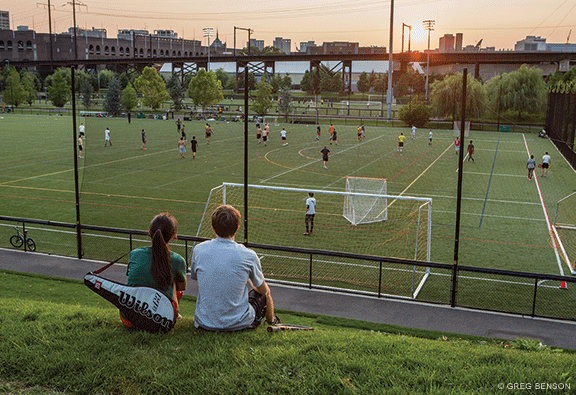
If there was any bright side to the complaints from frustrated Penn fans last season for Bilsky, it was hearing where they were calling from and how they had watched the game. For years, the only way to catch Penn basketball from out of town was to listen on the radio or follow the play-by-play on ESPN’s GameCast. But since the Ivy League Digital Network debuted last year, basketball fans of all eight Ivy schools have been able to watch every game online.
“When we were planning and implementing this, we heard from recruits, we heard from parents, we heard from alumni all over the country,” Bilsky says. “Even if they comment on not being happy about something, when we get a call from someone in Los Angeles and they say, ‘I saw the game on the digital network on Saturday, and I love the quality of the production but didn’t like the game,’ at least we accomplished one of our goals.”
Of course, the Ivy League Digital Network is not only for basketball and football. A total of 1,010 events were broadcast live for the 2013-14 season, with Penn showing 92 games across 12 sports. And more will be added in the future, with the long-term goal of broadcasting every game in every sport. Bilsky sees this as the best way to reach alumni and parents while growing support for Ivy League athletics—which, of course, ties back into the department’s fundraising efforts. (He also notes there’s “potentially money” to be made from subscription fees, though certainly nothing like the revenue the big athletic conferences have reeled in through their own networks.)
“I think it’s the most important initiative we’ve taken in the last five years,” Bilsky says. “Because whereas television is great, and you always want to be on television, the Ivy Network can reach every single person, anywhere in the world, who has access to some type of computer or handheld device.”
Bilsky has certainly been an advocate for television, helping the league secure a national contract with the NBC Sports Network for select basketball, football, and men’s lacrosse games. But recognizing the need for more exposure and control, he played an even greater role in the formation of the Ivy League Digital Network, taking the lead at league meetings, where he was, according to Ivy League Executive Director Robin Harris, the “main architect” of the plan.
“He’s just super smart and has great business acumen and a lot of experience,” Harris says. “He really has a way of looking beyond the obvious issues to get to the heart of the matter and to think of things that maybe aren’t so obvious that we should be considering as well.”
It wasn’t easy to get the Ivy League Digital Network off the ground, especially in the way Bilsky and others envisioned it. The big sticking point for Bilsky was that the streaming had to be very high quality—“as close to ESPN3 as we could get.” And that meant investing “hundreds of thousands of dollars just on equipment” for high-definition cameras, as well as making sure each school had capable announcers and provided good on-screen graphics.
Admittedly, other schools had to catch up to Penn, which was ahead of the curve with its own video team in place to run the Penn Sports Network. But Bilsky insisted that their production level “rise to the top.” And he’s been pleased with the results, leaving at a time when it appears that the Ivy League—led by Penn—is well-suited to take a leap into a new technological era and market their sports in a way they’ve never been able to before.
“I think it’s a game-changer,” says Calhoun, who’s ready to take the baton and run with it. “The more exposure you get, the better. For the Ivies, drawing from not only 50 states but internationally, the move toward digital—where it doesn’t matter what country you’re in or what time zone you’re in—is a huge advantage.”
As much as Bilsky has always wanted to do things big and take Penn to the next level, he never thought his alma mater should—or needed to—stray from its Ivy League principles of high academic standards and no athletic scholarships for student-athletes. Given the premier quality of the member schools and the availability of need-based financial aid, some Ivy League teams are able to recruit the best high-school athletes and compete for national championships—at Penn, for instance, both the men’s and women’s lacrosse teams have emerged as perennial Top 25 teams. It’s still possible to have the best of both worlds—as Bilsky himself did 45 years ago, enjoying great athletic success as a student before using his Wharton education to forge a similarly satisfying career after college.
“There is this tug of war going on,” Bilsky admits. “Yes, the pool of candidates is smaller. On the other hand, we have very fine coaches who have great facilities to work with and good budgets. And we represent the top schools in the country. So I see no lessening of our abilities to compete on a national level; if anything, I see it happening even more.”
Bilsky will get no arguments there from Calhoun. Both recognize the benefits of being a student-athlete at an Ivy League school—“Someone who’s played athletics at a high level like myself will say that being an intercollegiate athlete prepares you for life as well as anything else in college,” Bilsky says—and the important place that sports have in a college community.
There is occasionally some push-and-tug with the University’s administration about how prominent that role should be—but, Bilsky says, “I’ve seen that in other Ivy schools more than I’ve seen that at Penn.” In that sense, Calhoun shouldn’t expect much pushback as she looks to grow Penn athletics. Nor does she feel insecure about Penn’s place in the ever-changing NCAA hierarchy.
“I have always believed the Ivy League model is the ultimate experience because the Ivies are really the one conference that has never been confused about why we do college athletics,” Calhoun says. “Particularly in such a turbulent time when so much of the college athletic landscape is up in the air, it is reassuring to feel like you’re in a conference that has always followed these higher principles that have such consistency in membership and tradition.”
And yet, even if the Ivy League doesn’t change—and it never will, according to Harris, who says that “no one’s leaving and we’re not adding members”—the conference still may not be able to avoid the NCAA turbulence. Like many others, Bilsky fears that the five power conferences that have been scooping up so many new schools over the past few years—the Pac-12, the Southeastern Conference, the Big Ten, the Big 12, and the Atlantic Coast Conference—may soon seek more autonomy and perhaps even leave the NCAA altogether.
If that happens, where would that leave Penn?
“That’s where I hope and think the Ivy League can play a significant leadership role and become leaders of the remaining couple hundred schools,” Bilsky says. “Or the Ivy League will find itself with no allies and become kind of irrelevant. That’s my biggest fear for the future of athletics. We’ll just have no one to play.”
It’s a legitimate fear, and one that Al Bagnoli shares. One of the most successful coaches in school history, Bagnoli has made Penn football into an Ivy League force during his long tenure. But he’s frustrated that, due to an archaic rule originally intended to preserve academic integrity, the Ivy League bars its football teams from competing in the NCAA playoffs, making it the only sport that can’t win a national title. And he’s worried that there are few schools outside the Ivy League that Penn can compete with on a level playing field (read: ones that also don’t give athletic scholarships). “We’re going to have some philosophical questions that people are going to answer at some point,” Bagnoli says.
For the moment, Calhoun is more focused on the short-term goal of guiding Penn through Bagnoli’s impending retirement and the succession plan that has longtime assistant Ray Priore taking over as head coach at the end of the 2014 season. “It’s a crossroads, but a small one,” she says.
And she’s also already thinking of ways to boost attendance at Franklin Field (and the Palestra). Whereas Bilsky was of the mind that winning was the most important thing to get fans into a building—“When I played there was no marketing department, there was no promotion department,” he says—Calhoun seems to be a big proponent of marketing what she calls “the Penn brand,” which she believes should be a combination of the Quakers’ “rich tradition” with a new kind of “swagger” in the future. That includes educating students as early as freshman orientation with “fun things like teaching them cheers and doing a ‘Football 101,’” as well as “maximizing the entertainment experience” with promotions during games.
“I never believed that you have to build a successful program to build a fan base,” she says. “Because building a fan base and getting loud, crowded environments is one of the best ways to help support your team to be successful.”
This is one subject about which Bilsky and Calhoun have differing views, and there are surely others. And the challenges now are different, too. While Bilsky knew he had to upgrade the University’s athletic facilities, Calhoun may end up devoting much of her time and resources to, as Fuller calls it, “human capital”—whether that means adding staff members to keep pace with the athletic department’s growth or allowing for more professional development opportunities. Either way, the men’s soccer coach, who was on the committee that interviewed athletic-director candidates, is confident in the direction Calhoun will take the department, calling her “a leader for the times” because her “broad base of experience” can help Penn navigate the same changing NCAA landscape that so worries Bilsky.
Of course, it’s difficult to know what Penn athletics will look like in 20 years, just as it would have been hard to predict how much has changed over the last two decades under Bilsky. Whatever happens in the future, though, Calhoun hopes her tenure will have one thing in common with the man she’s succeeding. Just as Bilsky always wanted to retire at Penn, the new athletic director feels the same way.
“This is my seventh institution,” she says, gazing out the window to an empty Franklin Field stadium that will soon come alive. “And I made it really clear with my husband when discussing this that I want it to be my last institution.”
Dave Zeitlin C’03 writes frequently for the Gazette and oversees the magazine’s sports blog.


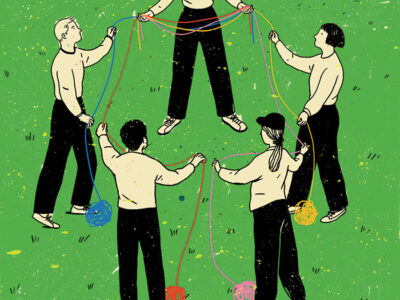
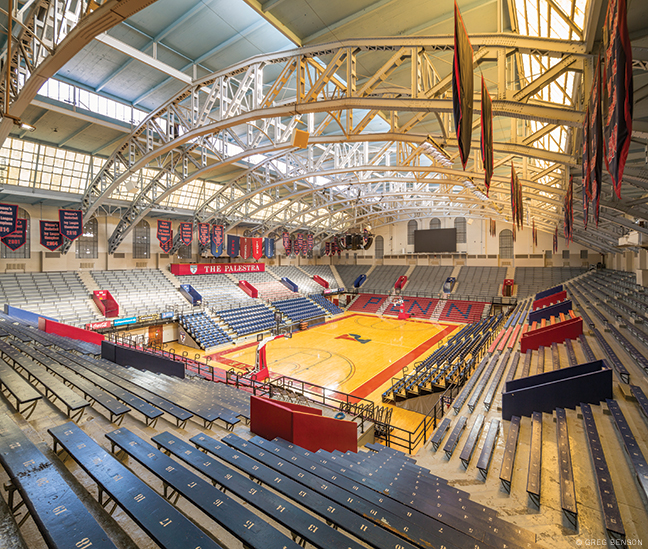
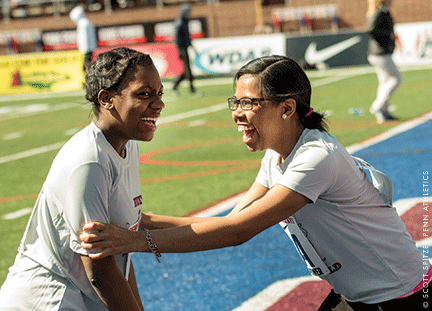
Good insights about the intersection of collegiate sports and athletic administration at a special place like Penn. Amazing that the AD was able to bring U2 to Franklin Field, too.